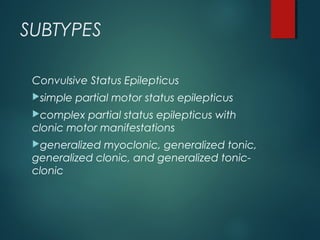Which of the Following Best Describes Status Epilepticus
A A seizure involving convulsions on only one side of the body b Two or more seizures with tonic-clonic activity without an intervening period of consciousness c A period of drowsiness following tonic-clonic seizures d A seizure that occurs without a known cause. Status epilepticus is a neurological emergency requiring immediate evaluation and management to prevent significant morbidity or mortality.
The rapid evaluation and treatment of convulsive status epilepticus is discussed below.

. Status epilepticus is a neurologic and medical emergency manifested by prolonged seizure activity or multiple seizures without return to baseline. A patient with status epilepticus has received an IV dose of lorazepam. For a patient with recurrent seizures who isnt actively seizing a more gradual approach may be taken with escalation if an active seizure re-emerges.
The recurrence of unprovoked seizures characterized by sudden attacks of altered consciousness motor activity or sensory impairment is called. Airway breathing and circulation. D A seizure that occurs without a known cause.
Ochsner is a 501c3 not-for-profit organization founded on providing the best patient care research and education. Definitions Seizure1 Finite episodes of disturbed cerebral function Status Epilepticus. Which of the following BEST describes status epilepticus.
Establish best practices in the use of EEG data and brain imaging findings to guide medical decisions. Which of the following best describes you. Refractory and Super Refractory Status Epilepticus - Presenters.
Absence complex partial simple. Get medical help right away if you have a convulsive seizure that lasts more than 5 minutes. Types of generalized seizures include tonic-clonic and.
There is a spectrum of severity dependent on the type of seizure underlying pathology comorbidities and appropriate and timely medical management. For someone who has seizures theyre normally similar in length each time they occur and typically stop once that time period has passed. While convulsive status epilepticus can be diagnosed using clinical features alone non-convulsive status epilepticus requires confirmation by electroencephalogram.
Status epilepticus SE is a medical emergency associated with significant morbidity and mortality. The definition classification clinical features and diagnosis of convulsive status epilepticus in adults are reviewed separately. Status epilepticus causes prolonged or repetitive seizures that if left untreated can lead to neuronal injury severe disability coma and death in paediatric and adult populations.
Status epilepticus SE is a common life-threatening neurologic disorder that is essentially an acute prolonged epileptic crisis see the image below. We are pleased to announce the 2022 workshop Management of Refractory and Super Refractory Status Epilepticus for Neurologists and Intensivists and hope you mark your calendar with the date and plan to be a part of this upcoming ACCME accredited program. B Two or more seizures with tonic-clonic activity without an intervening period of consciousness.
A It is a state of prolonged continuous seizure activity. SE is defined as a continuous seizure lasting more than 30 min or two or more seizures without full recovery of consciousness between any of them. Convulsive status epilepticus is a medical emergency.
Administration of anticonvulsants to cease seizure activity is key along with management of basic life support. C It is an irreversible progressive disease that leads to dementia. At the institution at which you trained phenytoin would be given next but the attending orders fosphenytoin.
Two or more seizures with tonic-clonic activity without an intervening period of consciousness You respond to a 32-year-old female who is having a seizure. A A seizure involving convulsions on only one side of the body. Which of the following best describes status epilepticus.
Establish best practices for the selection of therapeutic options in the management of Refractory and Super Refractory Status Epilepticus to achieve optimal outcomes. Within the following pages you will find our Exhibitor Prospectus which describes the Levels of. A focal seizure lasting 30 minutes B 45 minutes of intermittent periods of seizing and comatose state C 30 minutes of continuous seizure activity D two seizures.
Dropsy epilepsy status epilepticus seizure disorder. The duration of time in which a patient can be in convulsive status epilepticus before brain damage occurs is unknown. RationaleStatus epilepticus is a neurologic life-threatening emergency characterized by prolonged or clustered seizures in which consciousness does not return between seizures.
Which of the following best describes the main advantage of the fosphenytoin over phenytoin itself. D It is a medical emergency. Which of the following BEST describes status epilepticus.
Status epilepticus SE is a very severe type of seizure. Which of the following BEST describes status epilepticus. SE can represent an exacerbation of a preexisting seizure disorder or the initial manifestation of a seizure disorder epilepsy or it can represent an insult other than a seizure disorder.
C A period of drowsiness following tonic-clonic seizures. Status epilepticus is a medical and neurologic emergency that requires prompt evaluation and treatment. B It consists of frequently repeated seizures without the patient regaining consciousness.
Historical definition12 30 minutes of continuous seizure activity H2 seizures without full recovery of consciousness between the seizures. Previously status epilepticus was defined as a seizure with a duration equal to or greater than 30 minutes or a series of seizures in which the patient does not regain normal mental status between seizures. Incorporation of safe and ethical practices.
It is associated with substantial medical cost morbidity and mortality. This algorithm describes the approach to a convulsive generalized seizure lasting 5 minutes.

References In Status Epilepticus In Adults The Lancet Neurology

Commonly Performed Diagnostic Procedures In Pediatric Status Epilepticus Download Table


Comments
Post a Comment